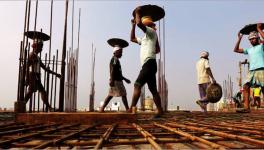ILO’s ‘High Wage Growth’ in India Based on Estimates, Not Real Data

Image Courtesy: NEEM Scheme
One of the International Labour Organisation’s flagship reports – the Global Wage Report 2018-19 – released recently said that wages of Indian workers grew at a healthy 5.5% per year after adjusting for inflation. This was the highest wage growth in the region, and among the highest in major economies except China. Mainstream media indulged in much back-slapping and celebration at this good news.
Trade unions and activists – and of course, workers themselves – were bemused and puzzled by this. The lived experience was quite the contrary with workers feeling the relentless squeeze of inflation as wages virtually stagnated. They had been fighting a battle with the government for increasing wages, with the government refusing to accede. So, how come the ILO was saying that wages were increasing at such a vigorous rate?
First, have a look at what the Global Wage Report says.
1. In a list of countries with their respective nominal wages (wages not adjusted to inflation) given in Appendix II, Table A1 (page 113), India’s monthly wages are given as Rs.9,194 for 2013, Rs.10,093 for 2014, Rs.10,885 for 2015 and Rs.11,674 for 2016.
These seem to be on the high side, considering that minimum wages for scheduled employments in most states is below Rs.10,000. The reason why you are getting puzzled is that these figures are from the Annual Survey of Industries (ASI) done by the Ministry of Statistics & Programme Implementation. ASI covers only the factory sector, that is, units covered under Factories Act. This is all organised sector, mostly big industrial units. Not included are agricultural workers and all the other unorganised sector workers, which together make up over 90% of India’s labour force.
This fact was confirmed by Xavier Estupiñan, Wage Specialist at the ILO, whom Newsclick contacted after publication of the report.
2. Next, the Global Wage Report in its Real Wages section of the same table gives the rate of growth of real wages for India as 5.2% in 2013, 5.7% in 2014 and 5.4% in 2015 (see page 118). A few pages later (p.122), a chart is given which shows real wage growth rates from 2008 to 2017 where India’s real wage growth is shown as averaging 5.5% in this period.
This is where ILO has undertaken some creative processing of data.
Newsclick asked ILO where this data was coming from and how they had developed the real wage growth over the years.
Estupiñan responded as follows: “The real wage growth shown in table A1 p.118 until 2015 is estimated through modelling, which we had already published in our previous Global Wage Report”.
So, it is not data collected by surveys or reports of any agency like the Labour Bureau or Central Statistics Office (CSO). It is mathematical modelling that has produced the laudable growth rate.
How exactly do they use a ‘model’ to project data for different years? Estupiñan explains that, “in accordance with our discussions with the Ministry of Labour, the real wage growth shown in the chart on page 122 uses the NSSO data when it exists, and fills in missing years with a model which makes use of ASI information”.
So, there you have it. In consultation with the Labour Ministry of India, ILO has used National Sample Survey Organisation (NSSO) data – which is last available for 2011-12 – and extrapolated from there using an unknown ‘model’ that uses ASI information. Remember – ASI covers only the organised manufacturing sector, while NSSO includes all workers of every kind. ASI is a survey done at enterprises while NSSO is a household survey. Under the creative guidance of the Labour Ministry itself, ILO has used this to create a time-series (and a graph) that shows a healthy real growth rate of 5.5% in wages.
Note that in its report, none of these clarifications are given. They were told to Newsclick when ILO was asked.
ILO Caveat on India Data
But, to be fair, ILO did raise some issues about Indian wage data earlier. In its India Wage Report issued in August this year, on page xvii, is written this warning, “An evidence-based approach to minimum wage fixing, collective bargaining and the development of adequate labour market policies requires regular production of good and reliable national data on employment, wages, productivity and hours worked, based on which policymakers can make informed decisions. In India, such data are not collected on a regular basis; due to this, even in this report the latest data for analysis refers to 2011–12. In this report, we raise for consideration some recommendations on improving coverage and data collection towards a more timely and in-depth empirical analysis, to effectively inform policymakers and social partners. Given the regional variation in levels, disparity and growth in wages there is a need for a more detailed understanding of the working of the labour markets at the state level. This calls for state-specific and comparative studies on wages and for collaborative work between government agencies, academic institutions and expert organizations”. (emphasis added)
Estupiñan was kind enough to point out this caveat to Newsclick while responding to the queries.
The bottomline is that ILO’s Global Wage Report cannot be relied upon to understand the trends in wage growth in India. The report has some important and valid comments on wages in countries where robust systems of data collection exist. It is pointing out important trends of wage stagnation and persistent wage gap between men and women.
But don’t take their word for how wages are growing in India.
Get the latest reports & analysis with people's perspective on Protests, movements & deep analytical videos, discussions of the current affairs in your Telegram app. Subscribe to NewsClick's Telegram channel & get Real-Time updates on stories, as they get published on our website.
























